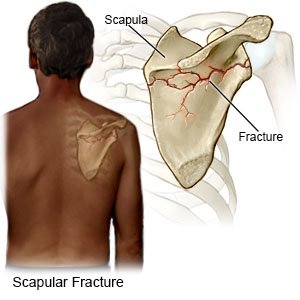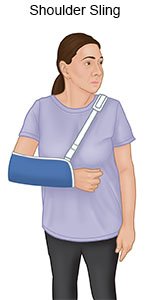Scapular Fracture
Medically reviewed by Drugs.com. Last updated on Aug 4, 2025.
What is a scapular fracture?
A scapular fracture is a break in your shoulder blade (scapula). Your collarbone, arm bones, lungs, or chest may also be affected.
 |
What are the signs and symptoms of a scapular fracture?
- Pain, tenderness, swelling, bruising, or a bump in the injured area
- Trouble moving your shoulder and arm
- Bones poking through your skin, or bones not looking normal
- Weak, numb, and tingly shoulder and arm
- The need to support your arm with your other hand to decrease pain
How is a scapular fracture diagnosed?
- X-rays of your scapula, collarbone, or arm bones may be checked for broken bones or other problems. X-rays of your lungs and both scapulas may also be taken.
- An MRI or CT scan may be used to check for a fracture or other injury. You may be given contrast liquid to help a fracture show up better in pictures. Tell the healthcare provider if you have ever had an allergic reaction to contrast liquid. Do not enter the MRI room with anything metal. Metal can cause serious injury. Tell the healthcare provider if you have any metal in or on your body.
How is a scapular fracture treated?
Treatment will depend on the damage and the kind of fracture you have. Most broken scapulas heal on their own.
- Medicines may be given to prevent or treat pain or a bacterial infection.
- A sling may be used to hold your arm in place and support your scapula while it heals.

- Physical therapy may be needed after your swelling and pain have improved. A physical therapist can teach you exercises to help improve movement and strength.
- Surgery may be used to place your bones back in their normal position if the fracture is severe. Pins, plates, and screws may be used to hold the bone together. Other problems may also need to be treated, such as an injury to a nerve, blood vessel, or other organs.
How can I manage my symptoms?
- Rest when you feel it is needed. Slowly start to do more each day. Return to your daily activities as directed.
- Apply ice to help decrease swelling and pain, and to prevent tissue damage. Use an ice pack, or put crushed ice in a plastic bag. Cover it with a towel and place it on your scapula. Apply ice for 15 to 20 minutes every hour, or as directed.
Call your local emergency number (911 in the US) if:
- You suddenly feel lightheaded and short of breath.
- You have chest pain when you take a deep breath or cough.
- You cough up blood.
When should I seek immediate care?
- You cannot move your fingers.
- Any part of your arm becomes blue, pale, cold, or numb.
- Your pain is not relieved or gets worse, even after you take pain medicine.
- Your arm feels warm, tender, and painful. It may look swollen and red.
When should I call my doctor?
- You have a fever.
- You have more swelling than you did before your arm was put into a sling.
- Your skin is itchy, swollen, or has a rash.
- You have questions or concerns about your condition or care.
Care Agreement
You have the right to help plan your care. Learn about your health condition and how it may be treated. Discuss treatment options with your healthcare providers to decide what care you want to receive. You always have the right to refuse treatment. The above information is an educational aid only. It is not intended as medical advice for individual conditions or treatments. Talk to your doctor, nurse or pharmacist before following any medical regimen to see if it is safe and effective for you.© Copyright Merative 2025 Information is for End User's use only and may not be sold, redistributed or otherwise used for commercial purposes.
Further information
Always consult your healthcare provider to ensure the information displayed on this page applies to your personal circumstances.
